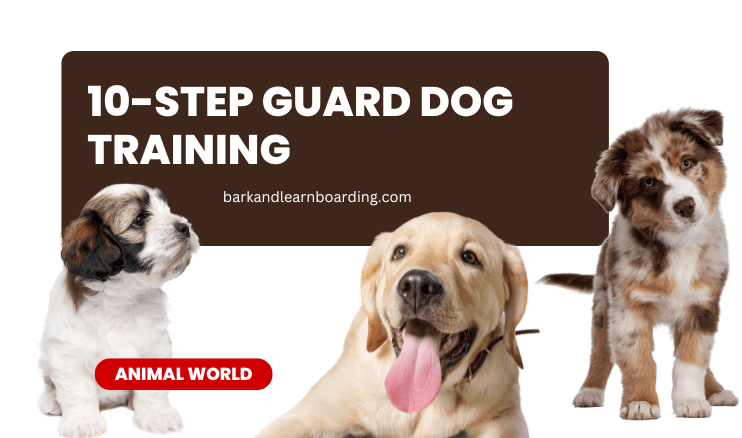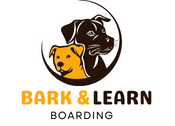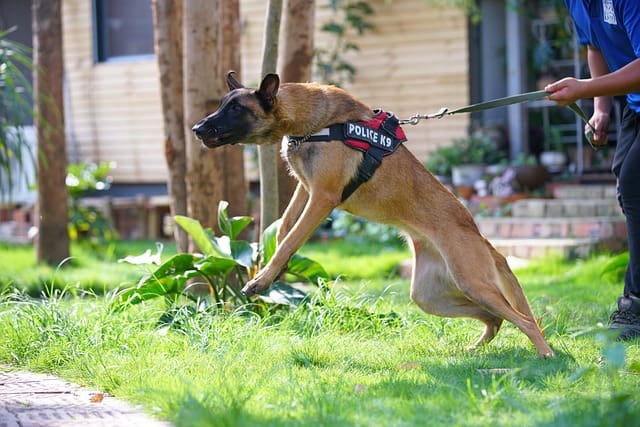Guard dog training …? Sounds awkward. Are we going to make our dogs guards?
Surprisingly, the answer is yes.
Guard dogs have been employed for centuries to protect property, livestock, and people. However, a guard dog’s effectiveness relies heavily on proper training.
Guard dog training is about instilling obedience and cultivating a strong bond between the dog and its handler.
This blog post covers the intricacies of guard dog training, from selecting the right breed to advanced training techniques.
So let’s start…
10-Step Guard Dog Training
With proper guidance and commitment, you can transform your beloved pet into a formidable protector, ready to defend and safeguard your home and loved ones.

Here is a 10-step guard dog training you can follow:
-
Understanding Guard Dog Training Breeds
Before embarking on the guard dog training journey, it is essential to choose a breed that aligns with your specific needs and preferences.
Some breeds are naturally suitable to excel in guarding roles due to their intelligence, temperament, and physical attributes.
German Shepherds, Rottweilers, Doberman Pinschers, and Belgian Malinois are among the most popular choices for guard dog training, thanks to their protective instincts, loyalty, and trainability.
However, each breed has unique characteristics and requirements, so thorough research is crucial before selecting.
-
Preparing for Gaurd Dog Training
Successful guard dog training begins with adequate preparation. Before diving into formal training sessions, ensure your dog’s basic needs are met.
This includes providing a nutritious diet, regular exercise, and proper healthcare. Additionally, create a conducive environment for training, free from distractions and conducive to learning. Invest in essential training equipment such as a sturdy leash, collar, and reward treats.
Establishing a rigid foundation of trust and communication with your dog is paramount to the training process.
-
Fundamentals of Gaurd Dog Training
Training a guard dog encompasses fundamental principles, including obedience, socialization, and protection.
Socialization is crucial to ensure your dog remains well-adjusted and comfortable in various environments and around different people and animals.
Introduce your dog to new experiences gradually, exposing them to different sights, sounds, and situations in a controlled manner.
-
Building Protective Instincts
Guard dogs possess innate protective instincts that can be cultivated and refined through targeted training.
Teach your dog to differentiate between friend and foe by exposing them to simulated threat scenarios while reinforcing appropriate responses.
Implement controlled aggression training under the supervision of a professional trainer to channel your dog’s protective instincts effectively.
It’s essential to balance assertiveness and restraint, ensuring your dog responds appropriately to threats without harming innocent individuals.
-
Socialization and Temperament Testing
A well-trained guard dog must be proficient in protection, possess a stable temperament, and interact calmly and safely with humans and other animals.
We discuss the importance of early socialization and temperament testing in shaping a well-rounded guard dog and provide insights into effective socialization strategies and temperament assessment protocols.
-
Maintaining Training Consistency
Establish and adhere to a structured training routine diligently, reinforcing learned behaviors through regular practice and repetition.
Monitor your dog’s progress closely, adjusting your training approach to address any challenges or setbacks.
Consistent correction of undesirable ones is essential for long-term success.
-
Legal and Ethical Considerations
Training a guard dog comes with legal and ethical responsibilities that must be noticed.
We explore the legal framework surrounding guard dog ownership and deployment, including liability issues and regulations governing the use of guard dogs in various contexts.
We also delve into ethical considerations such as responsible breeding practices and humane training methods, emphasizing the importance of prioritizing the dog’s welfare.
-
Integration into Security Protocols**
A well-trained guard dog can enhance security protocols for homes, businesses, and other properties.
Integrate your dog into existing security measures. Ensure that the dogs understand their role and responsibilities within the framework of your security strategy.
Coordinate with security personnel and other stakeholders to effectively leverage your dog’s capabilities, whether patrolling perimeters, conducting sweeps, or responding to suspicious activity.
1. Continuing Education and Development With Gaurd Dog Training:
Guard dog training is an ongoing process that requires dedication and commitment.
Challenge your dog with new training exercises and scenarios to sharpen its skills and instincts.
Attend workshops, seminars, and training courses to stay abreast of the latest guard dog training techniques and methodologies developments.
Invest time and resources in your dog’s ongoing education and development to maximize its potential as an effective guardian.
-
Real-World Applications of Gaurd Dog Training:
In the final chapter, we bring the concepts of guard dog training into real-world contexts, showcasing the diverse applications of trained guard dogs in security, law enforcement, search and rescue, and even as companions for individuals with specific needs.
Through case studies and testimonials, we illustrate the invaluable role that well-trained guard dogs play in enhancing safety and security across various domains.
Testimonial from Elena:
“Guard dog training changed our lives. With expert guidance, our German Shepherd, Max, transformed into a loyal protector. Max’s training gave us peace of mind, from mastering obedience commands to discerning potential threats. Thanks to our trainer, Sarah, Max isn’t just a guard dog; he’s a beloved family member dedicated to keeping us safe.”
Advanced Guard Dog Training Techniques
These techniques may include:
-
Alert Barking:
Teach your dog to differentiate between normal and suspicious noises and to bark to alert you of potential threats without being overly reactive.
-
Controlled Aggression:
Train your dog to show controlled aggression on command, deterring intruders while always remaining under your control.
-
Bite Inhibition:
Teach your dog to use appropriate force when apprehending an intruder, distinguishing between a threat and a non-threatening individual.
-
Boundary Control:
Establish clear boundaries for your dog’s patrol area and teach it to patrol and protect the designated territory effectively.
-
Recall Under Distraction:
Practice recalling your dog in various environments and situations, gradually increasing distractions to ensure reliable obedience even in challenging circumstances.
-
Tracking and Scent Work:
Introduce advanced techniques for training guard dogs to track individuals or objects using their keen sense of smell.
-
Distraction Training:
Provide strategies for desensitizing guard dogs to distractions while maintaining focus on their primary duties.
-
Defence Training:
Explore techniques for teaching guard dogs defensive maneuvers to protect themselves and their handlers in threatening situations.
Maintaining a Well-Trained Guard Dog
Regular Exercise and Stimulation:
Stress the importance of providing adequate physical and mental stimulation to keep guard dogs healthy, happy, and engaged.
Routine Maintenance:
Outline a schedule for ongoing training sessions, reinforcement exercises, and health checks to ensure continued success.
Conclusion
Guard dog training is a multifaceted endeavor that demands patience, expertise, and a genuine bond between handler and dog.
By understanding the unique characteristics of guard dog breeds, laying a solid foundation of basic obedience and socialization, and employing advanced training techniques, you can unlock your canine companion’s full potential as a loyal and vigilant guardian.
With proper training and ongoing support, your guard dog can become an indispensable asset in safeguarding your property, loved ones, and peace of mind.
FAQ’s
Q: What breeds are best suited for guard dog training?
A: Breeds commonly used for guard dog training include German Shepherds, Rottweilers, Doberman Pinschers, and Belgian Malinois. However, the suitability of a breed depends on various factors such as temperament, size, and energy level.
Q: At what age should guard dog training begin?
A: Guard dog training can begin at eight weeks old with essential socialization and obedience exercises. However, more formal training typically starts around six months when puppies have better attention spans and physical capabilities.
Q: Can any dog be trained as a guard dog?
A: While any other dog can be trained to bark at strangers, not all dogs possess the temperament or instincts required for practical guard dog work. Breeds with a strong protective instinct and high intelligence are generally more suitable for dog training.
Q: How long does guard dog training take?
A: The duration of guard dog training varies depending on factors like the dog’s breed, temperament, and the complexity of the training goals. Basic obedience training may take several weeks to months, while advanced training for specific tasks can take several months to a year or more.
Q: Is guard dog training safe for the dog and its handler?
A: Guard dog training, when conducted under the guidance of a professional trainer, can be safe for both the dog and its handler. Prioritize the dog’s safety and well-being throughout the training process.
Q: Can I train my guard dog, or should I be a professional trainer?
A: While it’s possible to train your guard dog with dedication, patience, and the proper knowledge, hiring a professional trainer can ensure more efficient and effective results. Professional trainers have experience working with guard dogs and can provide guidance tailored to your dog’s needs.
Q: Are guard dogs suitable for families with children?
A: Guard dogs can be suitable for families with children, but proper training and socialization are crucial to ensure the children’s and the dog’s safety. Teach children how to interact safely with the guard dog and supervise their interactions at all times.
Q: How do I maintain my guard dog’s training once completed?
A: Continual reinforcement and maintenance are essential for preserving your guard dog’s training. Schedule regular training sessions to reinforce learned behaviors, provide mental and physical stimulation through enrichment activities, and continue to build trust and respect in the handler-dog relationship.
Q: Are there legal requirements or restrictions for owning a guard dog?
A: Legal requirements and restrictions for owning a guard dog vary depending on location. Some areas may have regulations regarding the ownership, training, and use of guard dogs, so it’s essential to familiarise yourself with local laws and comply with any requirements.

